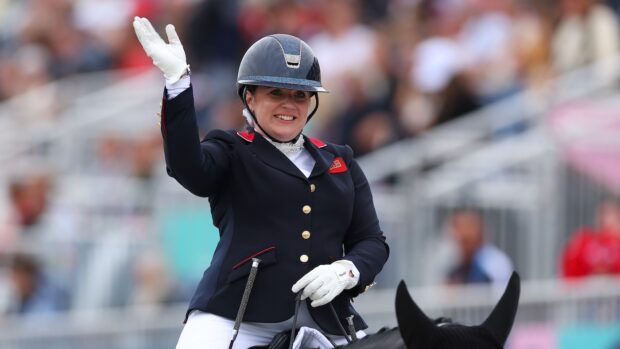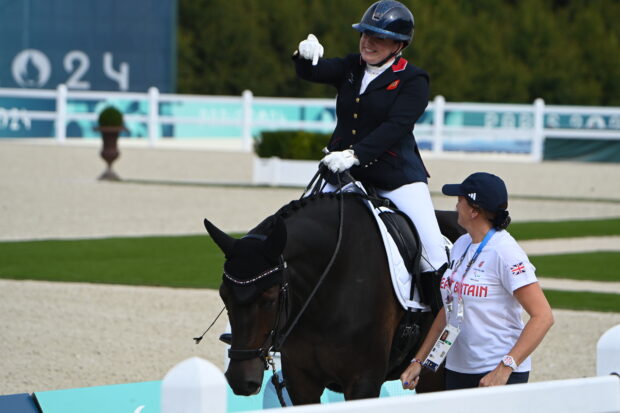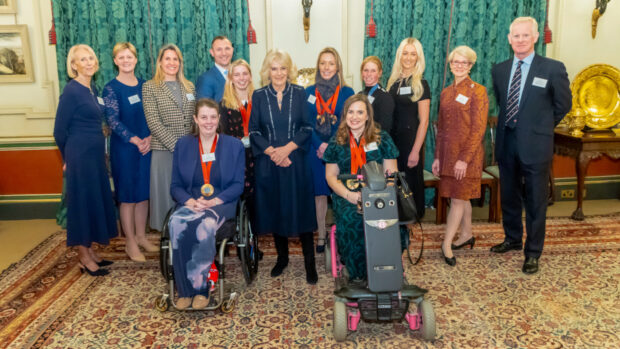The multi-medalled Paralympic rider chats to Polly Bryan about the highs and lows of her comeback in Tryon and why British para dressage needs a boost
“In January, if someone had written down what my perfect year would look like, this would be it,” says Natasha, fresh from the World Equestrian Games (WEG) in Tryon, where she scooped two silver medals aboard her ride of just eight months, the nine-year-old Mount St John Diva Dannebrog.
“Apart from the last day of WEG” she adds, cringing and laughing at the same time.
She’s referring to her freestyle, from which she made an early exit when the Don Schufro mare suddenly took fright and deposited Natasha on the floor with a large buck.
“It was so out of character for her — I have no idea what made her do it,” says the 28-year-old, who was unhurt in the fall and received a standing ovation as she left the arena with a wave on her pink scooter, Jordan.
It’s the sort of nightmare scenario that usually turns out to be a bad dream but, luckily, Natasha is the sort of upbeat, positive person who can take these things in her stride.
“It happens — it’s horses. Absolutely everybody falls off because we’re not riding machines,” she reasons.
But to focus on the fall would be to discredit Natasha’s achievements that week — claiming individual silver and topping the grade III leaderboard in the team test with a personal best that helped the British team secure silver. It may have been the first time Britain has ever failed to win team gold at a para dressage championship, but Natasha assures me that the team were genuinely delighted with their silver, just 0.6% behind the Netherlands.
“I actually don’t know why we were so expected to win gold,” she reflects, as we drink coffee in the tack room of her Uxbridge yard, 48 hours after her return from Tryon. “We had Sophie Wells, who we knew could deliver a big score, but the rest of us were on much less experienced horses and were unpredictable.”
It says a lot that, even though it didn’t all go to plan, Natasha is feeling “a million percent better” than after the 2014 WEG where she came home with individual silver and team gold, but still felt gutted.
“I’m second-best in the world after only eight months with Diva — that’s crazy. My biggest takeaway from these Games was how amazing she was in that team test and it makes me so excited for the future; if we can do that after eight months, what can we do after 18?”
Natasha and Diva are major British medal hopes for Tokyo in 2020. But after a tough 2017, Natasha didn’t know if WEG this year would be on the cards.
Following a glittering 2016, in which she won three gold medals at the Rio Paralympics, to add to her pair from London, Natasha’s life fell apart in February 2017, when her “horse of a lifetime”, Cabral, died suddenly after contracting a bacterial infection.
Even now, tears fill Natasha’s eyes when she talks about him, and she wears a ring containing one of his tail hairs so he can always be with her.
With the up-and-coming youngster she had at the time, Fireball, proving not quite forward-thinking enough for her to take to the top, Natasha made the difficult decision to take a year out of competition. Although she enjoyed spending a year “being a normal human being” and moving into a new flat with her boyfriend, Marc, she missed competing terribly, and grew more and more desperate as her hunt for a new horse proved fruitless.
Finally, at Christmas, after months of searching, she emailed Emma Blundell at the Mount St John stud in Yorkshire.
“At first Emma didn’t think she had anything suitable, but then asked if I would consider a lease, as one of her broodmares might be perfect,” says Natasha, who was given a glowing reference by Charlotte Dujardin.
That broodmare was Diva, who has continued to breed via embryo transfer alongside her dressage career with Natasha.
The pair have built up a remarkably strong partnership in the short time they’ve been together, but it’s worrying that one of the country’s most talented para riders came so close to not being able to represent Britain on the world stage at all this year.
Natasha points to horse power as one reason the Dutch in particular are beginning to pull away from the once all-conquering Brits.
“The horse power in para dressage is just insane now — it’s gone up so much since I’ve been involved in the sport,” says Natasha, who got into dressage through the Riding for the Disabled Association, and was talent-spotted for the World Class programme in 2002.
“The Dutch team have support from their federation to find and keep horses,” points out Natasha, also referring to the fact that three of the four team gold medal-winning horses at WEG are part of the NOP programme, which helps ensure horses with podium potential stay in the Netherlands. “But we don’t have such a good network over here to source horses, and they’re so expensive.”
Finding a horse with the necessary talent is one thing, but it’s quite another to find one who can adapt to a very different way of riding and cope with the atmosphere of the top level. Having contracted transverse myelitis as a toddler, Natasha was left with permanent nerve damage and severe weakness in her legs, which she has no use of while riding.
Instead, she uses her weight, her seat and her voice, and it makes for awe-inspiring viewing. Diva has taken to Natasha’s aids incredibly well, but their first championship together was still filled with unpredictability.
“I felt nervous on the first day because I had no idea what to expect from her. I didn’t know how she’d cope in the tunnel, in the arena, when people clapped,” Natasha says.
“We need to start getting our horses out into bigger environments more often — like the Dutch do. We have amazing shows in Britain — Windsor, Bolesworth, Olympia — but there’s no para dressage at them. There should be an opportunity for our horses to go into these environments, just as the able-bodied horses do. Even if it’s a showcase, or a demonstration, it would give our horses and riders exposure, and the sport as a whole, too.”
Natasha feels strongly that it’s time para dressage was no longer seen as secondary to its able-bodied equivalent. However, nowhere was this seen more clearly than in the difference in prize money across the two disciplines at WEG, with the gold medal-winning para team taking home just 7% of the money the winning dressage team received.
“We get complacent about the fact that we don’t have as much exposure; we were so happy that we won Longines watches at WEG like the rest that we didn’t care the prize money was so much less,” says Natasha. “But that should not be the case — we’ve just got used to playing second fiddle and, actually, it’s not good enough.”
The sport is lucky to have an ambassador such as Natasha, helping push its image deeper into other areas of equestrianism and change the stuffy concepts that still exist. She’s incredibly eloquent with an enviable confidence and poise that has helped her develop a successful career in dressage commentating alongside her riding. Having made her commentating debut at the Gothenburg Europeans in 2017, she has now landed the gig at all bar two of this winter’s FEI World Cup qualifiers, as well as the final.
She’s also making waves outside the horse world, too, being shortlisted alongside Mo Farah and Nicola Adams for the sports personality of the year category at the European Diversity Awards.
Continued below…

Subscribe to Horse & Hound magazine today – and enjoy unlimited website access all year round
It’s not bad for someone who used to be cripplingly shy.
“I can’t believe Natasha’s the same little girl who used to hide behind my legs and wouldn’t come out for a photo, unless it was on a pony,” laughs her mother, Lorraine.
But Natasha’s always been one to challenge perceptions and push for more, and now she’s looking ahead to 2019, excitedly making competition plans alongside the various other projects she has lined up.
“2017 was a really tricky year, but now everything’s pretty perfect,” she reflects, before flashing her trademark smile.
This article first appeared in Horse & Hound magazine on 4 October 2018.
For all the latest equestrian news and reports, don’t miss Horse & Hound magazine, out every Thursday




